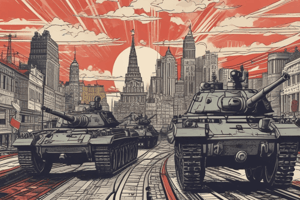Podcast
Questions and Answers
Why did countries receiving aid have to sign agreements compatible with the goals of the plan during the Cold War?
Why did countries receiving aid have to sign agreements compatible with the goals of the plan during the Cold War?
- To establish neutrality in the conflict between NATO and the Warsaw Pact.
- To strengthen military alliances with Eastern European countries.
- To gain economic benefits from the Soviet Union.
- To align themselves with the Western sphere of influence and distance from the Soviet Union. (correct)
Which military alliance was established in 1949 to focus on collective defense against the Soviet Union?
Which military alliance was established in 1949 to focus on collective defense against the Soviet Union?
- SEATO (Southeast Asia Treaty Organization)
- Warsaw Pact
- North Atlantic Treaty Organization (NATO) (correct)
- CENTO (Central Treaty Organization)
What event prompted the Western Allies to respond with the Berlin Airlift in 1948?
What event prompted the Western Allies to respond with the Berlin Airlift in 1948?
- Soviet Union's establishment of the Warsaw Pact
- Signing of economic agreements between Western and Eastern Europe
- Attempted blockade of West Berlin by the Soviet Union (correct)
- Fall of the Berlin Wall
What marked the beginning of the end of the Cold War, leading to events like the reunification of Germany?
What marked the beginning of the end of the Cold War, leading to events like the reunification of Germany?
Why is understanding the historical period of the Cold War considered crucial for contemporary international relations?
Why is understanding the historical period of the Cold War considered crucial for contemporary international relations?
What was a major concern as the Cold War order neared its end?
What was a major concern as the Cold War order neared its end?
What term refers to the geopolitical conflict between the Soviet Union and its satellite states against the majority of Europe and the Western hemisphere?
What term refers to the geopolitical conflict between the Soviet Union and its satellite states against the majority of Europe and the Western hemisphere?
Which event aimed to stimulate the economies of Western European countries devastated by World War II?
Which event aimed to stimulate the economies of Western European countries devastated by World War II?
What was the primary objective of the Marshall Plan introduced by the United States in 1947?
What was the primary objective of the Marshall Plan introduced by the United States in 1947?
What were the two opposing ideologies that emerged after World War II, leading to the division of Europe?
What were the two opposing ideologies that emerged after World War II, leading to the division of Europe?
During the Cold War, what characterized the relationship between the Soviet Union and its satellite states and Western powers?
During the Cold War, what characterized the relationship between the Soviet Union and its satellite states and Western powers?
How is the Cold War defined in terms of actual hostilities?
How is the Cold War defined in terms of actual hostilities?
Flashcards are hidden until you start studying
Study Notes
The Cold War in Europe
The term 'Cold War' refers to a geopolitical conflict that lasted from the late 1940s to the early 1990s, characterized by tense political and military tensions, high levels of espionage, and propaganda campaigns between the Soviet Union and its satellite states, collectively known as the Eastern Bloc, and the majority of Europe and the Western hemisphere, primarily the United States. The Cold War was a time of ideological and strategic competition rather than actual hostilities. Its impact can be seen across various aspects of life, including diplomacy, economics, and society.
The Beginning of Tension
The roots of the Cold War can be traced back to World War II, when the Soviet Union entered the war on the side of the Allies against Nazi Germany. After the war, two opposing ideologies emerged: the capitalist democratic model of the Western powers and the communist model of the Soviet Union. This led to a division of Europe into distinct political spheres.
The Marshall Plan
One of the most notable events in the early stages of the Cold War was the introduction of the Marshall Plan by the United States in 1947. Named after U.S. Secretary of State George C. Marshall, it aimed to stimulate the economies of Western European countries devastated by World War II. The plan offered financial assistance to rebuild infrastructure and boost industry, favoring free-market capitalism over the Soviet Union's planned economy. Countries receiving aid had to sign agreements compatible with the goals of the plan, effectively drawing them into the Western sphere of influence and away from the Soviet Union's sphere.
Military Allegiances
In addition to economic measures, military alliances were formed to counterbalance potential threats from the Soviet Union. The North Atlantic Treaty Organization (NATO) was established in 1949 by ten Western European countries and the United States, with a focus on collective defense. Conversely, in 1955, the Soviet Union and its Eastern European satellites formed the Warsaw Pact, responding to the perceived threat posed by NATO and the growing presence of the United States in Europe.
The Division of Germany
During this period, the city of Berlin became a focal point of tension, with German occupation zones being split into East and West. The Soviet Union attempted to blockade West Berlin in 1948, prompting the Western Allies to respond with the Berlin Airlift. No shots were fired, yet this event demonstrated the polarization between the two sides.
The Meltdown of the Cold War Order
As the Cold War drew to a close, scholars warned of instability arising from the collapse of the Cold War order. The increased likelihood of conflict and major crises was considered a challenge for Europe's political landscape. The fall of the Berlin Wall in 1989 marked the beginning of the end of the Cold War, leading to changes such as the reunification of Germany and the dissolution of the Soviet Union in 1991.
Conclusion
The influence of the Cold War can still be felt today, with echoes of its ideological division continuing to shape international relations. Understanding this historical period is crucial for understanding contemporary matters related to European integration, trans-Atlantic relations, and the broader geopolitical context of our times.
Studying That Suits You
Use AI to generate personalized quizzes and flashcards to suit your learning preferences.




